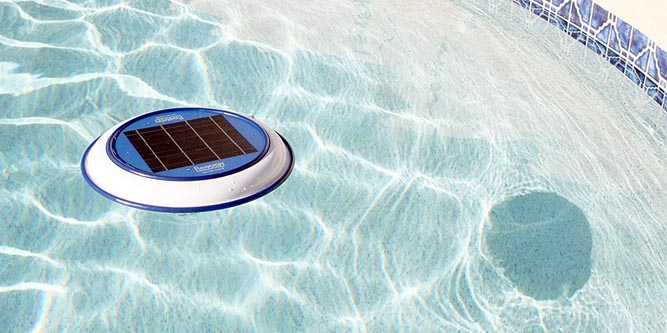A backyard swimming pool can make the difference between enjoying your yard and sweating in the sun. Instead of sweltering under an umbrella, you can dive in the water and really cool things down. But for many people, using a backyard pool is no laughing matter. Pool chemicals can cause irritation, particularly to the eyes and nose. And for sensitive individuals, this irritation can bring a fun afternoon to a screeching halt. Nonetheless, pool chemicals remain essential. Without them, your backyard water hole can quickly get overrun by algae, bacteria, and other pesky contaminants.
Being technology lovers, we’ve reviewed some of the latest pool gadgets before. We’ve looked at pool levelers, pool alarms, and even pool thermometers. Now, we’re about to look at solar ionizers to help reduce irritation in the pool. We’ll start with the SUNTOUCH TREASURES Solar Pool Maid Ionizer. This solar ionizer is full-sized, and capable of treating even the largest pools. Next, we’ll review the CopperFlo Solar Pool Ionizer. This ionizer is almost as big as the SUNTOUCH, and comes with a five-year manufacturer’s warranty. Finally, we’ll examine the Original Solar Ionizer. This is a more compact unit that comes at a more affordable price. Let’s get started!
What Do Pool Ionizers Do?
Pool ionizers produce electrically charged atoms called ions. These ions are similar to the original atoms, but cling to opposite-charged ions. For example, a negative ion and a positive ion will stick together, much like a negative and positive magnet. But not just any ion can be used to clean your swimming pool. To get the job done properly requires the proper type of atom.
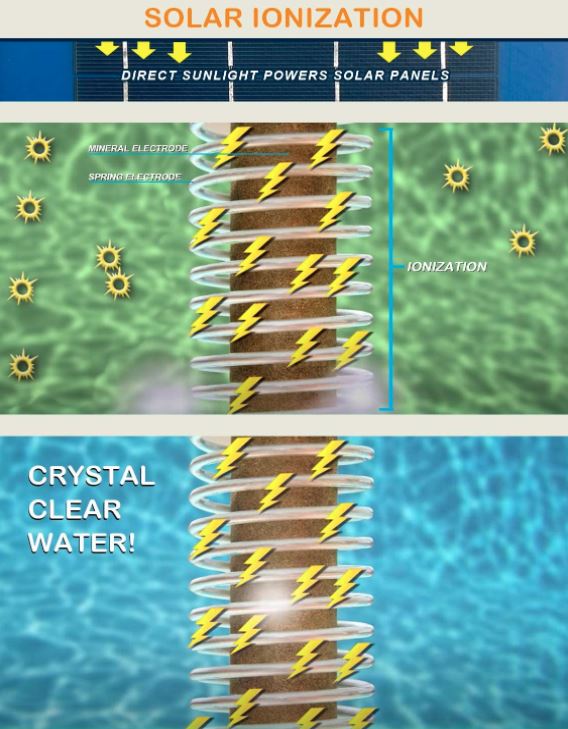
The magic of pool ionizers is performed by two types of metal: silver and copper. Silver has been known since Roman times for its antibacterial properties. Similarly, copper ions are already a main ingredient in many commercial algae killers. By combining copper and silver ions together, a pool ionizer can mitigate bacteria and algae growth. It’s important to keep in mind the word “mitigate”. This is a preventative tool, not a cure. If your pool already has algae, you’ll need to eliminate the algae before installing your ionizer.
Ion production requires electricity. Until recently, this has been an obstacle for home pool ionizers. After all, you don’t want a power cord running into your pool. But modern solar technology allows a small battery to keep your ionizer humming, making solar pool ionizers ideal for homeowners.
How Do Pool Ionizers Work?
Pool ionizers work by running your pool water over a series of copper and silver electrodes. These electrodes are clustered together, and are powered by a low-voltage DC current. As long as the current is active, the electrodes will continue to produce metal ions. In built-in pool ionizers, these electrodes are generally located inside the filtration system. They’re installed in the return jets, where they act as the final step in the filtration process. In a solar ionizer, the electrodes are typically exposed on the bottom side of the unit. As the ionizer floats around, water naturally flows through. This eliminates the need for extra power to operate a pump.
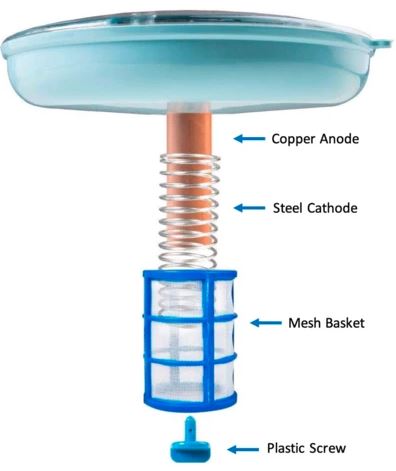
The type of ions produced by a pool ionizer are called “cations”. Cations are positively-charged ions, and will float freely through the water until they encounter “anions”, or negatively-charged ions. These ions are often found in microorganisms such as bacteria and algae. Remember how opposite-charged ions cling to each other? When a copper ion attaches to an algae cell or a silver ion attaches to a bacterium, it acts as a poison. Best of all, these ions are harmless to humans, so your family can swim safely while the ionizer is active.
We should stress again, though, that pool ionizers are a mitigation strategy that works as part of an overall plan. An ionizer on its own won’t keep a pool fully sanitized, no matter how small the pool. The reason for this is that ionizers are not good oxidizers. As a result, about 20 percent of bacteria will survive ionizer treatment with no negative effects. In other words, you’re still going to have to use some chlorine.
Fortunately, you won’t have to use nearly as much chlorine as you normally would. The ionizer will do the bulk of the work. So you only need 0.5 to 1 parts per million (ppm) of chlorine. Compare that to the 1 to 3 ppm required for a non-ionized pool. This significantly lower chlorine level can help individuals who experience irritation from chlorine exposure. It also saves money, since you’ll be using as little as a sixth as much chlorine as you otherwise would.
Some people advocate weekly chlorine shock treatments instead of regular supplementation. On the one hand, this may be sound advice for some people. For instance, if you only swim on the weekend, a Thursday or Friday shock treatment can make sense. On the other hand, you rely on chlorine to protect yourself and your family from dangerous diseases. So you can’t go chlorine-free, and you have to shock treat shortly before using the pool. In many cases, this can backfire, resulting in higher chlorine levels while you’re using the pool. The overall average chlorine level may be lower, but who cares if it’s near zero when the pool is unoccupied? Regular supplementation ensures a steady, low level of chlorine that isn’t just sanitary, but also less irritating.
Keeping your chlorine level lower is one major benefit of using a pool ionizer. However, ionizers also have a few other unique requirements. Before you buy one, make sure you can keep your water within these ranges:
- pH: 7.2-7.6
- Alkalinity: 80-120ppm
- Total dissolved solids (TDS): 500-1,000ppm
- Calcium hardness: 200-300ppm
There are a couple of exceptions to these guidelines. First off, the TDS can be higher. It simply requires you to clean your electrodes from time to time. Do this with a stiff wire brush as often as needed to keep clean metal showing. Second, the calcium hardness can also be higher; you just have to clean more often. There is an upper limit to calcium hardness, however. At around 500ppm, there is so much calcium in the water that the ionizer will not work effectively.
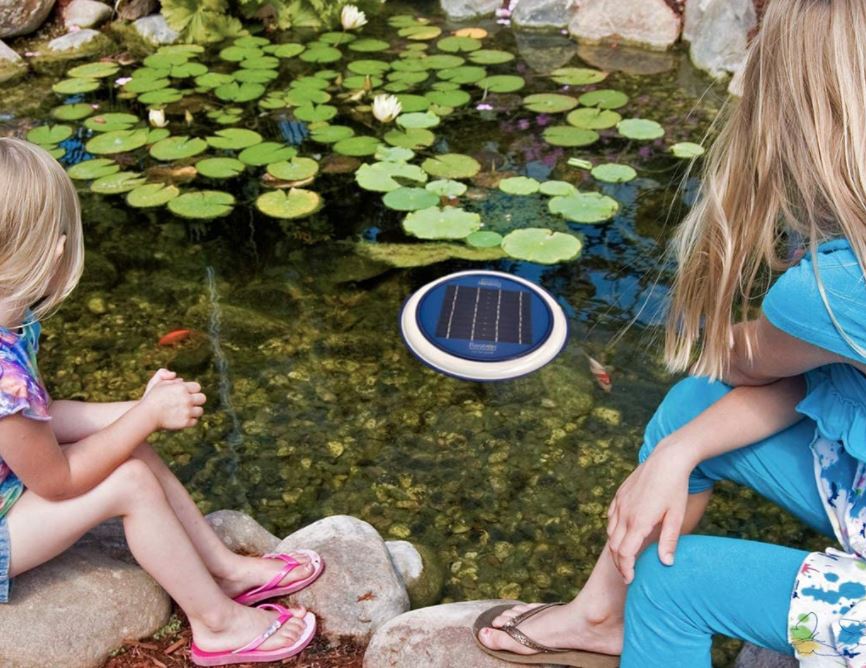
Pool Ionizer Benefits and Drawbacks
As with any home improvement, there are both upsides and downsides to owning a solar pool ionizer. Here’s a quick list of what you should expect when you drop one of these devices into your pool.
Your skin will thank you
Chlorine does a great job of killing bacteria and algae. Unfortunately, this works because it’s a toxic, caustic chemical. This is why it dries out your skin, stiffens your hair, and makes your eyes burn. Depending on how sensitive you are, this can ruin an otherwise wonderful weekend. Because an ionizer doesn’t produce any caustic chemicals, it won’t irritate your skin. You can relax in the water for hours, without worrying about itching or burning.
You’ll save money
As we already mentioned, some amount of chlorine is still required to maintain a healthy pool. Regardless, you’re still looking at a reduction, and oftentimes a significant reduction. This is a good thing for your family’s health and safety, but it’s also good for your wallet. After a year or two of using a pool ionizer, it will have paid for itself in chemical savings.
Shock treatment schedules are easy to forget
If you’re regularly supplementing your pool’s chlorine, missing one day isn’t a huge deal. On the other hand, if you’re performing a weekly shock treatment, missing a treatment can be a big problem. Bacteria can multiply to the point where they’re dangerous, endangering your family. This is why it’s a good idea to stick with regular supplementation. If you prefer shock treatment, consider setting a calendar alert or phone alarm. That way, you’re not going to forget and miss a week.
Ionizers can be messy
A pool ionizer releases copper and silver ions into your pool. When they interact with anions, they oxidize, or rust. This can cause discoloration, particularly around the bottom of the pool where the rust tends to settle. Thankfully, there’s a simple solution to this problem; just add a metal sequestrant to your cleaning routine. This chemical will cause oxidized metals to remain buoyant and get sucked through the filter. From they’re, they’ll be removed by your pool filter along with other contaminants.
Ionizers are easy on pool equipment
Remember how we said chlorine is a caustic chemical? This doesn’t just take a toll on your body; it also affects your pump, filter, and other equipment. To be fair, any decent hardware is built with chlorine exposure in mind. But even the hardiest equipment will eventually wear out and fail after years of exposure. A pool ionizer allows you to use less chlorine, which directly translates to less equipment wear. This can save you thousands of dollars in repairs, quite the payback on a small investment.
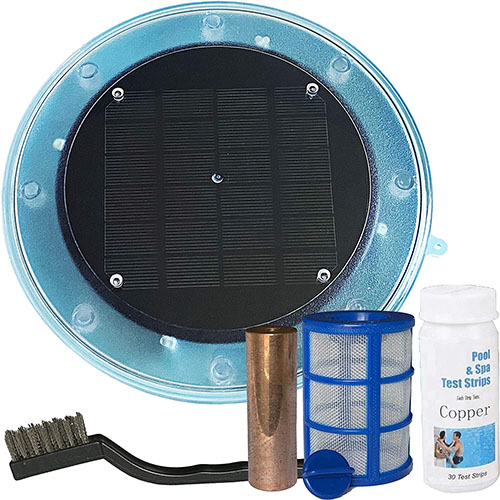
SUNTOUCH TREASURES Solar Pool Maid Ionizer
The SUNTOUCH TREASURES Solar Pool Maid Ionizer is a large device. It measures 12 inches in diameter and 5.5 inches tall, although most of the height is just the electrode. It sports an attractive blue and white design, with a square solar panel on the top. The electrode itself consists of an inner copper mineral electrode and an outer silver spring electrode. A second mineral electrode is included in the kit for easy replacement. Moreover, you can also get all consumable parts directly from the manufacturer. This includes strainer baskets, mineral electrodes, ion test kits, and spring electrodes.

The SUNTOUCH ionizer is rated to treat up to 35,000 gallons, and can do so reliably. Even in warm, algae-friendly climates, you can treat a 35,000-gallon pool with no issues. The existing electrodes should last for one or two seasons. Your exact performance will depend on pool size, pH, local weather, and other conditions. Regardless, you’re covered by SUNTOUCH’s 24-month manufacturer’s warranty. If anything goes wrong, you’ll receive either a replacement or a full refund.
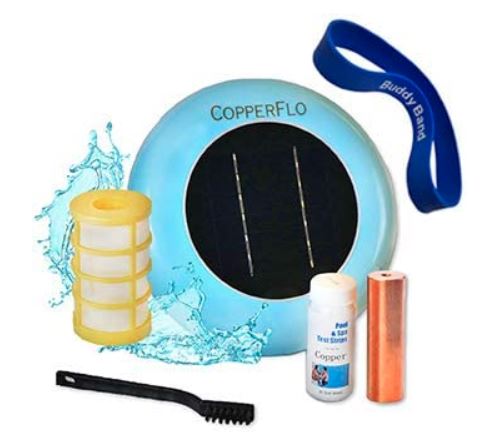
CopperFlo Solar Pool Ionizer
The CopperFlo Solar Pool Ionizer is slightly smaller than the SUNTOUCH, measuring 10.91 x 10.39 inches. It’s effectively round, and a bit taller than the SUNTOUCH, at 7.52 inches. Most of this consists of the electrode, which also consists of mineral and spring elements. The visible part of the unit is baby blue, with a square black solar panel in the center.
The CopperFlo ionizer is rated to treat up to 45,000 gallons, but this is generous. In some climates, it’s up to the task. But in hotter, muggier areas, 30,000 gallons is a more reasonable expectation. The electrode is rated to last for two to three years before it needs replacement, providing plenty of value. Not only that, but you get a robust lifetime warranty. Your unit will be replaced within the first year, or replaced at half price any time after that.
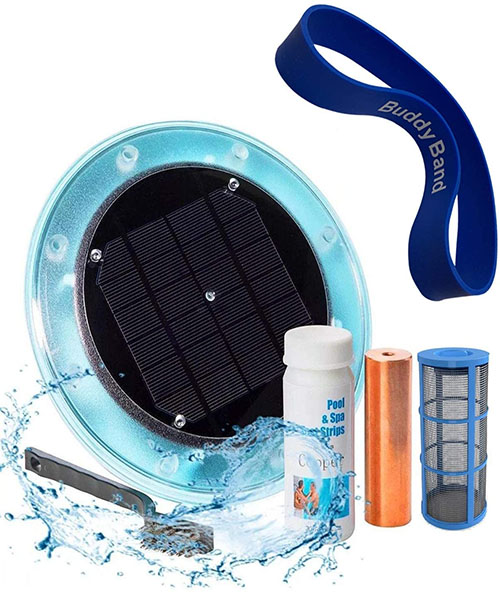
Original Solar Pool Ionizer
The Original Solar Pool Ionizer is the smallest on our list, measuring 9.6 x 9.1 inches in diameter. It’s also 6.5 inches tall, including the electrode. The top consists of a textured blue ring, which surrounds an inner solar panel. The ionizer is rated for up to 40,000 gallons, but 25,000 to 30,000 is more reasonable in warmer climates. That said, the price is very reasonable, although there’s no warranty if anything goes wrong.
Final Verdict
Which one of these is the best solar pool ionizer will depend on exactly what you need. To start with, we looked at the SUNTOUCH TREASURES Solar Pool Maid Ionizer. This is the most powerful ionizer on our list, but it comes with a hefty price tag. Next, we reviewed the CopperFlo Solar Pool Ionizer. This ionizer comes with an impressive lifetime warranty, so it’s great for tough swimming pools Finally, we looked at the Original Solar Pool Ionizer. The Original ionizer is a bit smaller than the first two, and comes at a more affordable price.
Meet Ry, “TechGuru,” a 36-year-old technology enthusiast with a deep passion for tech innovations. With extensive experience, he specializes in gaming hardware and software, and has expertise in gadgets, custom PCs, and audio.
Besides writing about tech and reviewing new products, he enjoys traveling, hiking, and photography. Committed to keeping up with the latest industry trends, he aims to guide readers in making informed tech decisions.

